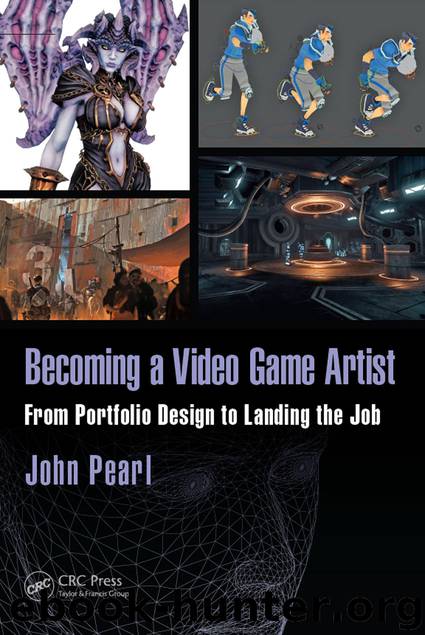Becoming a Video Game Artist by John Pearl

Author:John Pearl
Language: eng
Format: epub
Publisher: CRC Press
Criticism
Every artist should strive to grow and expand their skills and abilities. One way to experience that growth is through critique. The first lesson any production artist must learn is the ability to take critique. Critique and criticism can be positive or negative; however, hopefully it is constructive. The point of exposing your work to critique is to get feedback that comes from someone who is removed or not attached to the art as much as you are. This can be peers, teachers, or even online forums. Once you do, remember that sometimes your first reaction might be to feel defensive. However, there is no reason to feel the need to defend yourself; allow the criticism to come unfettered. After it has been given, it is your choice what you do with it. You can choose to ignore it, or react to it by making changes to your work. Often inexperienced artists feel that critique from a lead or an art director is an attack on them personally; this is largely because they see no separation between their work and themselves. As an artist working on a game, you need to realize that it is no longer “your” work as it contributes to a much larger goal; a finished game. This is an important stage of growth every game artist needs to realize at some point. Critique is not a personal attack, and your work is not you. Once you are working for a company, you are using your skills to craft someone else’s vision which you may not always agree with. Learn to take criticism in stride and grow from it, don’t fight it.
Prior to getting a job, and even after getting one, peer feedback is a great place to get initial feedback for any piece of work. Peers can offer insight from a similar but slightly different perspective. Peers may be doing similar but not exactly the same work as you oftentimes and can see your work from a “distance.” They can offer artistic feedback as well as technical feedback or offer up alternative creation methods. As any game artist will tell you, most of their learning was done while on the job and it was probably from their peers. If you have the opportunity to be in a 3d class, seek feedback from your classmates regularly. This can help you to not only improve your work but also get used to receiving critiques.
In addition to in-person critiques, another great place to get feedback is online 3d forums. However, having access to so many different places to display your work, it’s easy to get overwhelmed with the feedback. Also like most social interactions on the Internet much of the posting is done anonymously. This is exceptionally bad when attempting to receive consistent feedback from posting your work. Unless you are a regular on that forum already, you probably have no idea who is posting or their ability to critique. That’s why it’s still usually better to get feedback in person if it’s available because you have some context for the opinion.
Download
This site does not store any files on its server. We only index and link to content provided by other sites. Please contact the content providers to delete copyright contents if any and email us, we'll remove relevant links or contents immediately.
Kathy Andrews Collection by Kathy Andrews(11730)
Thirteen Reasons Why by Jay Asher(8796)
The Red Files by Lee Winter(3368)
How to Do Nothing by Jenny Odell(3232)
The Genius of Japanese Carpentry by Azby Brown(3226)
Stacked Decks by The Rotenberg Collection(2812)
Tattoo Art by Doralba Picerno(2600)
Champions of Illusion by Susana Martinez-Conde & Stephen Macknik(2414)
The Artist's Way Workbook by Cameron Julia(2196)
The Art of Doom by Bethesda(2108)
Calligraphy For Dummies by Jim Bennett(1992)
Creative Character Design by Bryan Tillman(1889)
Botanical Line Drawing by Peggy Dean(1812)
Wall and Piece by Banksy(1781)
The Art of Creative Watercolor by Danielle Donaldson(1777)
One Drawing A Day by Veronica Lawlor(1767)
Art Of Atari by Tim Lapetino(1750)
Pillars of Eternity Guidebook by Obsidian Entertainment(1626)
Happy Hand Lettering by Jen Wagner(1558)
